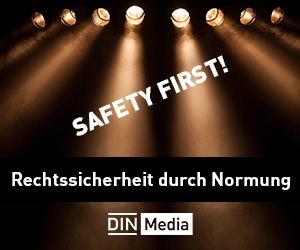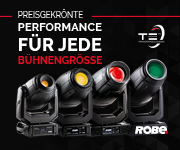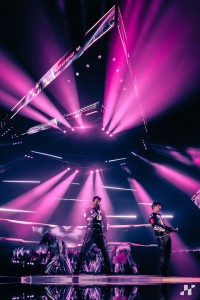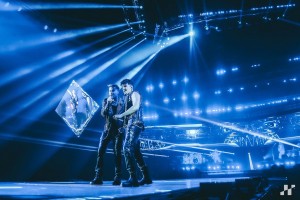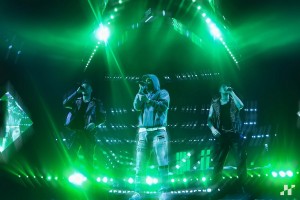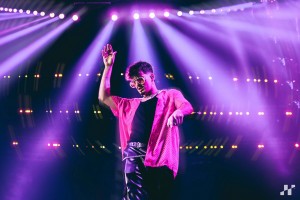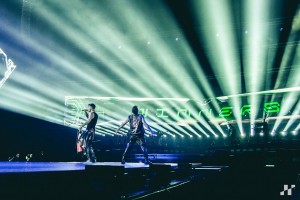Aktuelle News & Schlagzeilen
Valmar concert at Budapest Arena lit with Robe
Máté Lukacsovics and Ale Geszler from Budapest, Hungary-based lighting design studio Highlight Studios created a design for a one-off concert by Hungarian pop-rock band Valmar at the 12,500-capacity Budapest Arena, which was completely sold out. It was the band’s largest concert to date.
Lukacsovics and Geszler utilised over 150 Robe moving lights - a combination of iFortes, Pointes and Tarrantulas. Their starting point for lighting the show was the production design idea from show director Roland Mák who imagined the stage as a gigantic time machine, with the concert designed as a 2-hour gameplay session hosted by an AI character lurking on the outer IMAG screens.
The game involved performers and the audience completing various challenges and moving up to the next levels, and the 96 Pointes on the lighting rig were an integral part of this gameplay visualisation. Lukacsovics, Geszler, Mák and choreographer Sándor Kurucz all worked closely on realising this concept. The set, video and lighting designs were all based around Mák’s vision which Lukacsovics drew proportionally into the Arena’s own 3D model.
A V-shaped structure - the largest part on an automation system - was central to the aesthetic, flown above a runway coming off the stage, enabling over forty lights to be moving above the audience during the show. The LED wall setup followed Mák’s time machine, with an LED floor providing gameplay visuals with instructions and cards appearing on it for the performers. The AI character alternated with a live mix on the two IMAG screens, and the time machine interface also appeared on these same screens. The rear V-shaped main screen mainly featured textures and more informal background gameplay visuals.
Lukacsovics, Geszler and Mák all agreed at the outset that beam style fixtures should play a major role in filling the space and emphasising key moments of the game narrative. “It was important to choose a multifunctional light, with weight also a crucial factor due to the additional dynamics of the largest V-truss, which moved throughout the show”, says Lukacsovics. The 96 Pointes they chose, supplied by rental company Light Positive, were at the very essence of the show, and used extensively during the choruses. “The speed was beneficial, especially for the faster and rockier songs in the set list, allowing us to create high-impact effects with this number of lights”, notes Lukacsovics.
The Pointes were primarily used in beam mode, however for slower songs, a combination of prisms and gobos facilitated some dramatic epic looks. The beam reducers were utilised to boost the visibility of performers, especially when using the brighter colours, ensuring the focus stayed on them rather than lighting being dominant. “We also appreciate the beam reducer when achieving laser-simulation effects”, says Geszler.
Eighteen iFortes were rigged on the rear trusses and kicked in as back beams and effects, with forty Tarrantulas lining both sides of the catwalk on 20-metre straight trusses flown directly above. The iFortes were used for spot effects and highlighting the musicians; the Tarrantulas were used for washing the stage and the catwalk.
It was vital for the dancers and musicians to be well-lit, especially with saturated colour as the production was also recorded for TV. At times, up to 100 dancers were onstage simultaneously. The show’s video content was produced by Kata Kertész and her team. Despite tight deadlines, Lukacsovics and Geszler coordinated extensively with them, exchanging 3D renderings discussing proportions and colour schemes.
A favourite song in the set was the finale, “Színvak” (Colorblind), which specifically featured interactions between visuals and light. Visual content was mapped across the lighting elements throughout the song, including lasers, and sudden colour shifts and fades created a unique effect. Lukacsovics and Geszler spent two full days working with Dominika Sárhegyi from the video crew on this song, to ensure frame accuracy between lighting and visual transitions.
The concert also featured numerous between-song timecode-based interludes - when the time machine came to life as the AI character and assigned new tasks to the audience and performers - with the time machine highlighted by lighting and visuals “technocratic” effects as the story embraced the notion of technology as integral to the production.
Technically, the execution team faced a complex task because, in addition to rigging and automation, they had to fly the LED walls and lights with great precision. “Light Positive and the Szatyi Stage Team, who provided the LED wall, did a fantastic job”, says Geszler. Lasers and MDG atmosphere were supplied by Prolaser Kft, with automation and stage motion by E-Motion Technologies Kft.
Lukacsovics and Geszler as Highlight Studios remain independent in their brand choices as appropriate to each individual project, and their opinion is often sought by rental companies who are comparing lighting fixtures ahead of an investment. They particularly enjoy using Robe products on their TV work - which includes lighting live music broadcasts like “The Voice”, “X-Factor”, “Masked Singer”, “Starbox”, “Game Of Talents”, etc. “We can’t imagine a TV show without a RoboSpot system”, says Lukacsovics.
(Photos: Zsolt Kósa)
SCHLAGZEILEN
news archiv
suche
© 1999 - 2025 Entertainment Technology Press Limited News Stories

